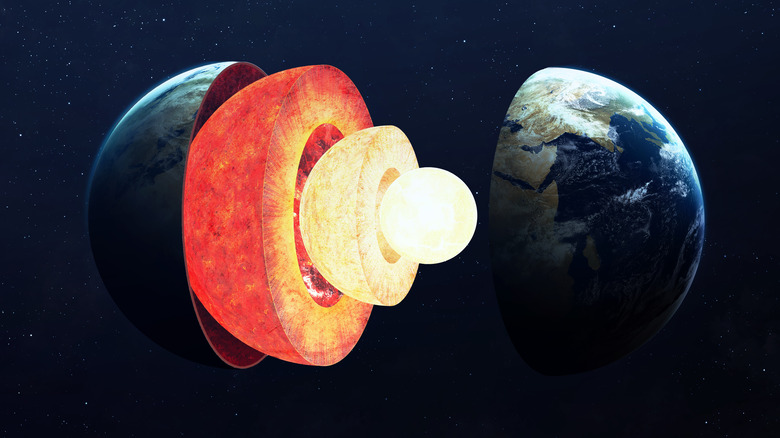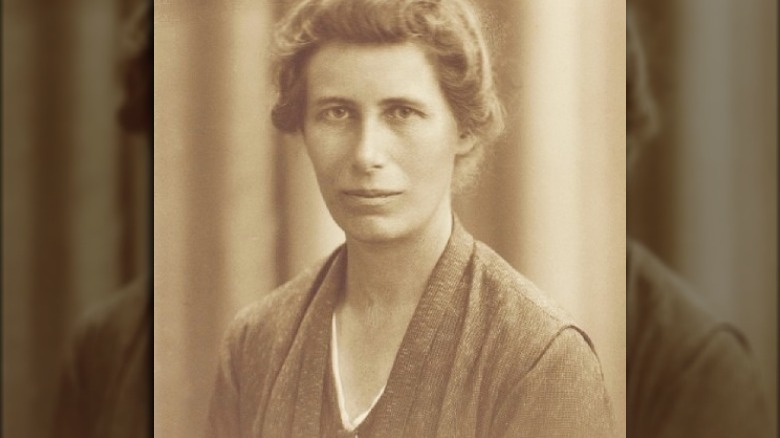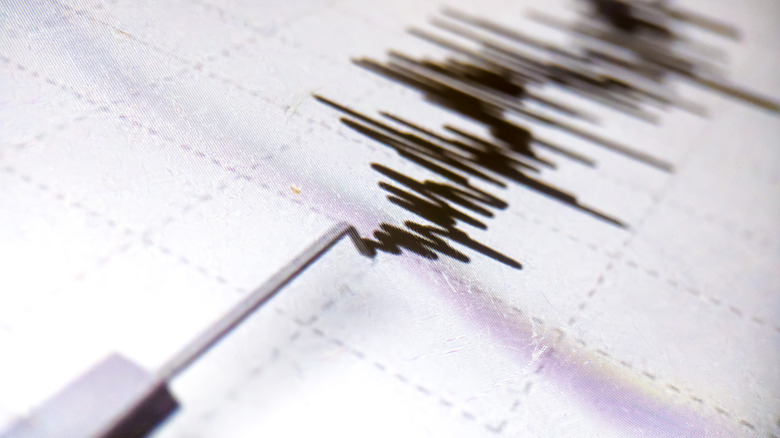The Truth About The Woman Who Discovered Earth's Core
If you've ever taken a grade-school-level science class, you've probably seen an image of Earth cut in half, or with a big slice removed from it. In these pictures, Earth resembles a jawbreaker candy; it has numerous, brightly colored layers of varying widths. Of course, this isn't exactly what our planet would look like if you sliced it open, but it does offer a helpful way to understand Earth's internal layers. On Earth's outside (where we live) is the rocky crust. Below that is the mostly solid mantle — Earth's thickest layer, per Phys.org. Deeper still is the outer core, which is made of molten hot liquid metal.
Until the 1930s, those were all the layers we knew about, Phys.org continues. But in 1936, the final layer was discovered: a solid inner core that takes up about 20% of Earth's full radius. This innermost layer is believed to be composed of an iron-nickel alloy, and is about as hot as the surface of the Sun, per the BBC.
Given how incredibly deep this inner core is, it's not surprising that it took a long time for scientists to detect it. Ultimately, this discovery was made by a Danish seismologist named Inge Lehmann. Lehmann's work studying earthquakes led her to infer the presence of Earth's solid inner core in 1936.
Inge Lehmann was a successful Danish seismologist
Per the Encyclopedia Britannica, Inge Lehmann was born in Copenhagen, Denmark in 1888. Lehmann attended a progressive high school that treated male and female students equally. This respect towards women students was quite unusual at the time, but it helped Lehmann to prepare herself for a successful academic career. In 1920, Lehmann got a candidata magisterii — the Danish equivalent of a master's degree — in mathematics.
Lehmann soon began serving as an assistant to a professional seismologist — that is, someone who studies earthquakes and related phenomena — despite having no formal training in seismology herself. Lehmann's work was intense. She was personally responsible for helping to establish Denmark's first seismic stations — both outside Copenhagen as well as in Greenland (a territory of Denmark).
Lehmann found seismology fascinating and decided to go back to school to study it further. So, in 1928, she obtained her second master's degree. That same year, Lehmann was chosen to lead the seismological department of the Royal Danish Geodetic Institute. In that position, Lehmann was responsible for running the newly established seismic stations in Denmark and Greenland. Lehmann used these stations to investigate a number of seismological questions. Among these, Lehmann was particularly interested in studying the speed at which seismic waves travel through different layers of the Earth.
Lehmann discovered Earth's inner core by studying seismic waves after a major earthquake
Then, in 1929, Lehmann finally got her big break. That year, a 7.3 magnitude earthquake hit New Zealand, sending seismic waves shaking throughout the inner Earth, per GeoNet. When Lehmann examined the seismic data in the aftermath of this earthquake, she found that some seismic waves appeared to "bend" in direction as they passed through the center of the Earth, as though they were being deflected by something.
Lehmann published her findings in 1936 and suggested that this shift in angle may likely be due to an as-yet-undiscovered "inner core" at the center of the Earth, per the Encyclopedia Britannica. Lehmann was right, of course — and she was far ahead of her peers. In fact, it was not until 1970 that seismograph technology became advanced enough to definitively prove that Earth's solid inner core actually exists.
Lehmann's seismological career spanned several more decades; she continued to study Earth's core, as well as its mantle. After a lengthy retirement, Inge Lehmann died in February of 1993 at the age of 104.


